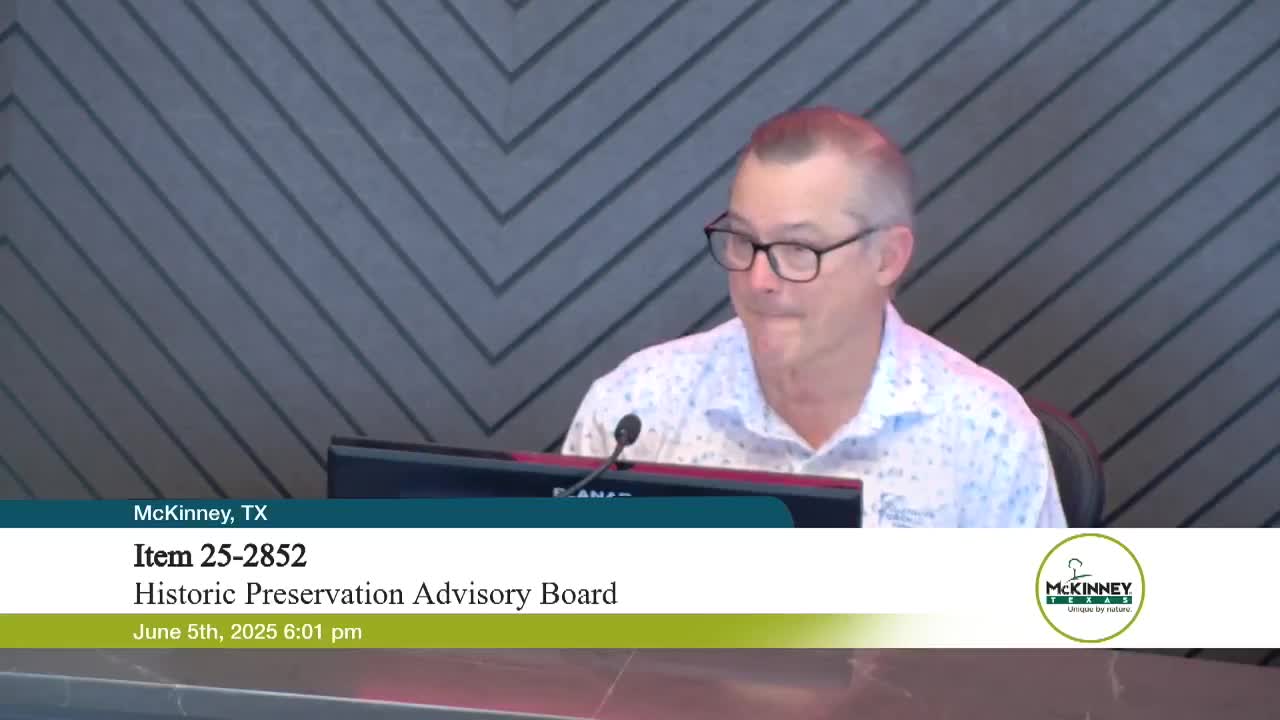East McKinney plans historic resource survey and community cleanup initiatives
June 05, 2025 | McKinney, Collin County, Texas
This article was created by AI summarizing key points discussed. AI makes mistakes, so for full details and context, please refer to the video of the full meeting. Please report any errors so we can fix them. Report an error »

The McKinney Historic Preservation Advisory Board meeting on June 5, 2025, focused on the ongoing efforts to enhance the city's historic preservation initiatives, particularly in underrepresented neighborhoods. Key discussions revolved around the findings from a recent historic resource survey, which identified potential areas for inclusion in the historic district and emphasized the need for further research into Black and Hispanic neighborhoods.
During the meeting, board members highlighted the significance of the 2023 historic resource survey, which was the first to document all five legacy neighborhoods across Highway 5. This comprehensive survey aims to fill gaps identified in previous surveys conducted in 1985, 2005, and 2015. The board is also launching a historic marker project to document significant sites on the East Side, including the original Holy Family School and Holy Family Church.
Additionally, the board discussed the need for updates to the historic preservation map, which will include priority ratings for historical significance and links to certificates of appropriateness. A new GIS analyst has been hired to facilitate these updates, with plans to have photos and priority ratings available by the end of summer.
Concerns were raised about community cleanliness, specifically regarding the accumulation of trash in certain areas. Board members expressed frustration over the lack of city maintenance in these neighborhoods and emphasized the importance of addressing such issues to build trust within the community.
The meeting also touched on community engagement efforts, including a recent East Side community conversation that aimed to foster dialogue between city leadership and residents. Feedback from these discussions has led to quick responses from the city, such as the installation of a protected left turn signal at a busy intersection, demonstrating a commitment to addressing community concerns.
Overall, the meeting underscored the board's dedication to preserving McKinney's historical heritage while actively engaging with and responding to the needs of its diverse neighborhoods. The next steps include continuing research, enhancing community communication, and implementing preservation initiatives that reflect the city's rich cultural history.
During the meeting, board members highlighted the significance of the 2023 historic resource survey, which was the first to document all five legacy neighborhoods across Highway 5. This comprehensive survey aims to fill gaps identified in previous surveys conducted in 1985, 2005, and 2015. The board is also launching a historic marker project to document significant sites on the East Side, including the original Holy Family School and Holy Family Church.
Additionally, the board discussed the need for updates to the historic preservation map, which will include priority ratings for historical significance and links to certificates of appropriateness. A new GIS analyst has been hired to facilitate these updates, with plans to have photos and priority ratings available by the end of summer.
Concerns were raised about community cleanliness, specifically regarding the accumulation of trash in certain areas. Board members expressed frustration over the lack of city maintenance in these neighborhoods and emphasized the importance of addressing such issues to build trust within the community.
The meeting also touched on community engagement efforts, including a recent East Side community conversation that aimed to foster dialogue between city leadership and residents. Feedback from these discussions has led to quick responses from the city, such as the installation of a protected left turn signal at a busy intersection, demonstrating a commitment to addressing community concerns.
Overall, the meeting underscored the board's dedication to preserving McKinney's historical heritage while actively engaging with and responding to the needs of its diverse neighborhoods. The next steps include continuing research, enhancing community communication, and implementing preservation initiatives that reflect the city's rich cultural history.
View full meeting
This article is based on a recent meeting—watch the full video and explore the complete transcript for deeper insights into the discussion.
View full meeting
